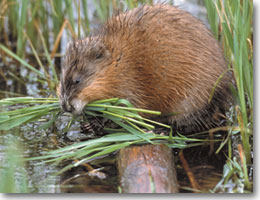Similar to a keystone which provides the stability to an archway, a keystone species helps provide stability to the surrounding ecosystem. Most animals play a vital role in the well-being of their local environments and the other species that inhabit them, but some deliver more critical services that are essential to maintaining balance. Some animals build new nests or burrows year after year while other animals borrow these discarded homes and would be without shelter if this keystone species was lost.
Pollinators like bumblebees, butterflies, and hummingbirds help sustain the next generation of plants by cross-fertilizing which produces fruits, seeds and vegetables for other animals to eat. Predators like wasps, wolves and cougars help prevent herbivores like beetles, rabbits and deer from over-eating those plants so that they can be pollinated again in future seasons.
Keystone species may also sustain the soil and water quality. Wolves may prey on deer which prevents the deer from eating too many saplings in a given area. This allows shoots to develop into large trees, whose root systems prevent erosion and support river banks. The rivers can then maintain adequate depths, turbidity, nutrient levels and temperatures to support fish and other aquatic plants and animals.
Alberta is home to a number of keystone species. These include beavers whose dams create ecosystems for many other animals like moose and ducks, Richardson’s ground squirrels whose underground tunneling aerates the soil to support native grasses while also providing shelter to other animals and grey wolves who help to maintain a healthy population of ungulates. Without these important species, ecosystems may become imbalanced which in turn could lead to an increase in the number of displaced wildlife that end up in conflict with humans and who ultimately find their way into AIWC’s care.
For more information on Alberta’s wildlife, book an education program with our knowledgeable staff and volunteers. To support AIWC’s ongoing care of keystone species and other wildlife in Alberta, consider adopting an animal, donating to items from our wish list, purchasing your copy of Scared Skunk or volunteering at the centre.
By Stephanie Ruddock, AIWC Volunteer






